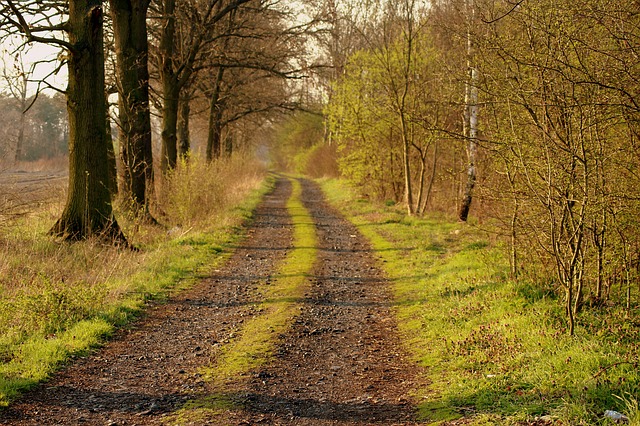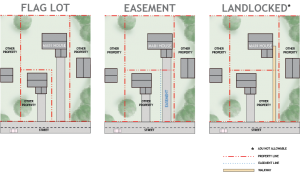
LAND LOCKED IN INDIANA
The term “land locked” refers to a parcel of real estate that has no direct access to a public road or highway due to being surrounded by parcels owned by other landowners. This situation is not common but does occur within the State of Indiana as well as all other states within the Union. Since the laws regarding property are specific to each state, this brief article will focus on the solutions to such problems under Indiana law.
In a perfect world every conveyance of land would result in a parcel to a new owner with access to a public road. However, that most generally occurs when the conveyance is intentional, voluntary, and accommodating to the necessity for ingress and egress. When a parcel is conveyed by other means, such as a tax sale deed, sheriff’s deed, or executor’s deed, access to public roads may not be assured.
Imagine owning a parcel of land that you cannot walk to or drive to. The only way to get to or from the land-locked parcel is by air. Such a limitation would render the property virtually useless to most people. Fortunately, Indiana law does have a solution in many cases.
The owner of a land-locked property should contact the owners of the neighboring properties and attempt to negotiate an easement over their land that will allow access to the land-locked property. This might be handled directly, or with the aid of a real estate agent or real estate attorney. A formal document drawn up describing an easement in terms of scope of use, location and dimensions can be negotiated to accomplish this. The party seeking an easement over the neighbor’s land generally pays for that right, just as if they were buying a parcel of real estate. If successful, the easement would be recorded in the county recorder’s office and referenced in all future deeds thereby giving notice to the world that a right of one landowner to cross the other landowners property in a designated spot is now permanent and will be conveyed to subsequent owners of both properties.
Neighboring landowners are not always willing to agree to such an arrangement, which almost always necessitates a lawsuit seeking the help of a Judge. Indiana law has given land-locked property owners the assistance they need for access to public roads by either declaring the existence of a public highway or an implied easement over the lands of a neighboring landowner.
 Indiana courts have given a broad definition to the term “public highway” in limited circumstances. Where evidence is produced to demonstrate a path of common travel has been used for a period of twenty years prior to 1988 (when Indiana codified a more restrictive definition of public highway) Indiana courts have declared such a path to be a public highway. So, the use of the path must be shown to have been in use by 1968 or earlier. This use has few if any restrictions. Evidence of this use need not show any number of users. It need not show the frequency of the travel or its particular use. It need not be defined by structures or gravel, pavement or any other material. It also does not matter that the path terminates on the land-locked property or that the only people who used it were the people who either lived on the land-locked parcel or their guests. This remedy will be more difficult to prove as the years roll on, because much of the evidence necessary to demonstrate this use will die off with the people who would have personal knowledge of it.
Indiana courts have given a broad definition to the term “public highway” in limited circumstances. Where evidence is produced to demonstrate a path of common travel has been used for a period of twenty years prior to 1988 (when Indiana codified a more restrictive definition of public highway) Indiana courts have declared such a path to be a public highway. So, the use of the path must be shown to have been in use by 1968 or earlier. This use has few if any restrictions. Evidence of this use need not show any number of users. It need not show the frequency of the travel or its particular use. It need not be defined by structures or gravel, pavement or any other material. It also does not matter that the path terminates on the land-locked property or that the only people who used it were the people who either lived on the land-locked parcel or their guests. This remedy will be more difficult to prove as the years roll on, because much of the evidence necessary to demonstrate this use will die off with the people who would have personal knowledge of it.
More frequently, owners of land locked parcels seek to establish an implied easement, either by necessity or prior use. An easement by necessity can only be granted where the land-locked landowner can show that his or her access to a public road was cut off by a severance of a servant parcel. There must be evidence of “unity of title” showing the severed parcel was owned by the same owner immediately prior to severance. There can be no gap in that ownership. A parcel is servant to another parcel where it must permit the other landowner to cross its property. The servant property must bow to the dominant parcel to allow for such ingress and egress.
A similar remedy to the land-locked property owner is accomplished by establishing an easement by prior use. However, proof of the prior use relieves the plaintiff of the need to prove absolute necessity in the need to access a public road. A recent appeal by an Indiana court described the difference between easement by necessity and prior use as “An easement of necessity will be implied only when there has been a severance of the unity of ownership of a tract of land in such a way as to leave one part without any access to a public road. On the other hand, an easement of prior use will be implied where, during the unity of title, an owner imposes an apparently permanent and obvious servitude on one part of the land in favor of another part and the servitude is in use when the parts are severed . . . if the servitude is reasonably necessary for the fair enjoyment of the part benefited. Unlike a landowner requesting an easement by necessity, a landowner requesting an easement by prior use does not need to show absolute necessity. The focus of a claim for an easement by prior use is the intention for continuous use, while the focus of a claim for an easement by necessity is the fact of absolute necessity.” Collins v. Metro Real Estate Services LLC, 72 N.E.3d 1007, (Ind.App. 2017).
If you have land-locked property and unsympathetic neighbors, you are going to need to hire a real estate attorney and seek the court’s assistance in securing a court ordered access.








